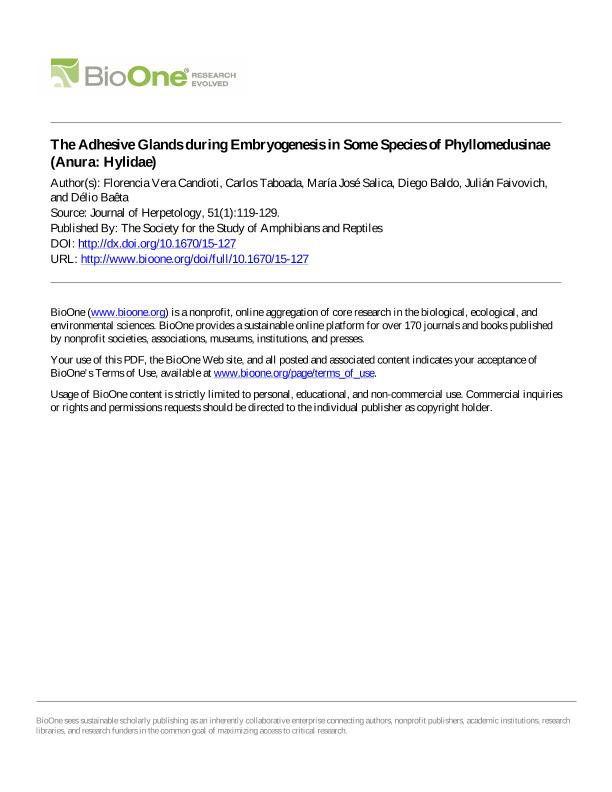Artículo
Among anuran embryonic structures, the adhesive (cement) glands appear posterolaterally to the stomodeum and produce a mucous secretion that adheres embryos to surfaces in and out of the egg. In this paper, we study the ontogeny of the adhesive glands in five species of Phyllomedusa representing the two main clades recognized in the genus, plus embryos of Agalychnis aspera and Phasmahyla cochranae. Clutches were collected in the field, and embryos were periodically fixed to obtain complete developmental series and then studied with a stereomicroscope, scanning electron microscopy and routine histological techniques. Structural variations include glands absent (in P. cochranae and Phyllomedusa boliviana), functional club-shaped glands (morphogenetic Type C in Phyllomedusa sauvagii, Phyllomedusa iheringii, and Phyllomedusa tetraploidea), and an unusual Type C-like pattern in Phyllomedusa azurea, characterized by large, oblong glands in a horseshoe-like disposition around the oral disc. This latter gland configuration is similar to that of A. aspera. Interspecific variations also include the arrangement and regression pattern of the secretory region, which are in turn different from those of Type C glands in other clades. To interpret the origin and evolution of gland developmental patterns in the group, we still need information on gland occurrence and development in the basal genera of Phyllomedusinae (Phrynomedusa and Cruziohyla) and in the basal taxa of the two major clades of Phyllomedusa. Entre las estructuras embrionarias de los anuros, las glándulas adhesivas (o de cemento) aparecen posterolaterales al estomodeo y producen una secreción mucosa que adhiere los embriones a las superficies dentro y fuera del huevo. En este trabajo estudiamos la ontogenia de las glándulas adhesivas de cinco especies de Phyllomedusa, representantes de los dos principales clados reconocidos en el género, y de embriones de Agalychnis aspera y Phasmahyla cochranae. Las puestas se colectaron en el campo, los embriones fueron fijados periódicamente para obtener series de desarrollo completas y luego estudiados con lupa estereoscópica, microscopía electrónica de barrido y técnicas histológicas de rutina. Las variaciones estructurales incluyen glándulas ausentes (en P. cochranae y Phyllomedusa boliviana), glándulas cónicas funcionales (Tipo morfogenético C, en Phyllomedusa sauvagii, Phyllomedusa iheringii y Phyllomedusa tetraploidea), y un patrón similar al Tipo C inusual en P. azurea, caracterizado por ser glándulas grandes, oblongas, con una disposición en herradura en torno al disco oral. Este último patrón es comparable al observado en A. aspera. Las variaciones interespecíficas también conciernen al arreglo y patrón de regresión de la región secretora, a su vez diferentes del de glándulas Tipo C de otros clados. Aún se requiere información sobre la ocurrencia y desarrollo de las glándulas en géneros basales de Phyllomedusinae (Phrynomedusa y Cruziohyla), y en los taxones basales de los dos clados principales de Phyllomedusa, a fin de interpretar el origen y evolución de los patrones morfogenéticos de las glándulas adhesivas en el grupo.
The adhesive glands during embryogenesis in some species of Phyllomedusinae (Amphibia: Anura: Hylidae)
Vera Candioti, María Florencia ; Taboada, Carlos Alberto
; Taboada, Carlos Alberto ; Salica, María José
; Salica, María José ; Baldo, Juan Diego
; Baldo, Juan Diego ; Faivovich, Julián
; Faivovich, Julián ; Pontes Baêta Da Costa, Délio
; Pontes Baêta Da Costa, Délio
 ; Taboada, Carlos Alberto
; Taboada, Carlos Alberto ; Salica, María José
; Salica, María José ; Baldo, Juan Diego
; Baldo, Juan Diego ; Faivovich, Julián
; Faivovich, Julián ; Pontes Baêta Da Costa, Délio
; Pontes Baêta Da Costa, Délio
Fecha de publicación:
01/2017
Editorial:
Society for the Study of Amphibians and Reptiles
Revista:
Journal of Herpetology
ISSN:
0022-1511
Idioma:
Inglés
Tipo de recurso:
Artículo publicado
Clasificación temática:
Resumen
Palabras clave:
Anura
,
Phyllomedusinae
,
Anatomy
Archivos asociados
Licencia
Identificadores
Colecciones
Articulos(MACNBR)
Articulos de MUSEO ARG.DE CS.NAT "BERNARDINO RIVADAVIA"
Articulos de MUSEO ARG.DE CS.NAT "BERNARDINO RIVADAVIA"
Citación
Vera Candioti, María Florencia; Taboada, Carlos Alberto; Salica, María José; Baldo, Juan Diego; Faivovich, Julián; et al.; The adhesive glands during embryogenesis in some species of Phyllomedusinae (Amphibia: Anura: Hylidae); Society for the Study of Amphibians and Reptiles; Journal of Herpetology; 51; 1-2017; 119-129
Compartir
Altmétricas



